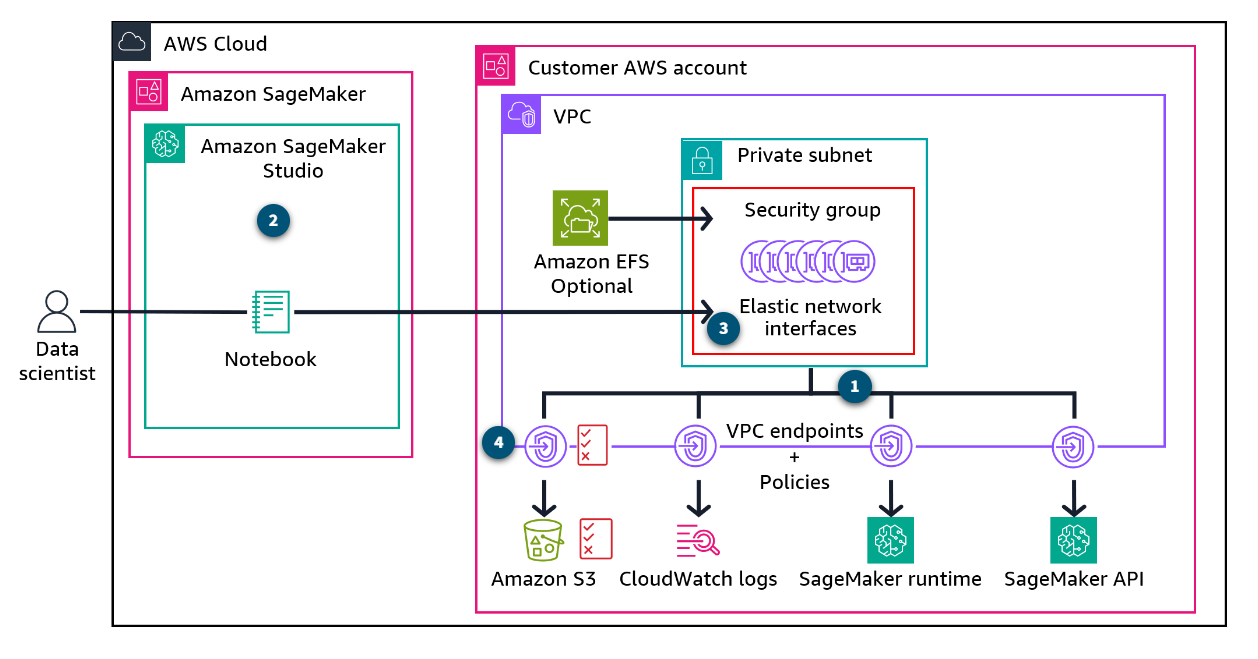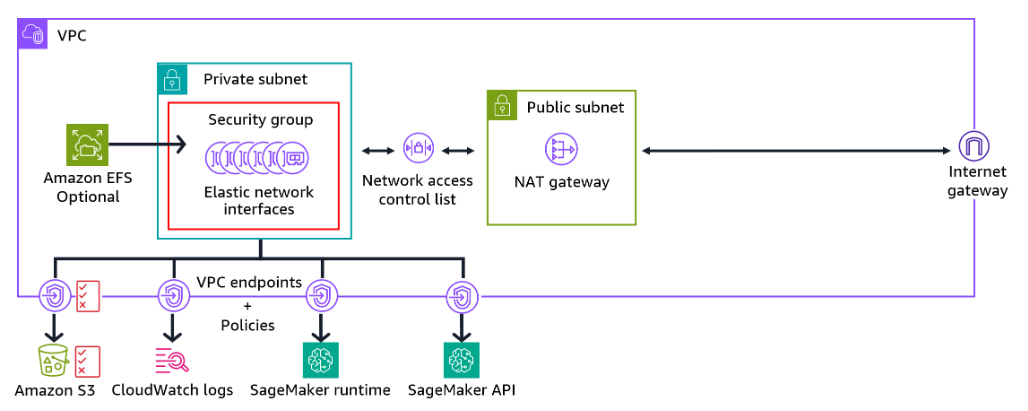Secure AWS ML Resources
Securing ML Resources
Section titled “Securing ML Resources”Securing AWS Resources in Your ML Solution
Section titled “Securing AWS Resources in Your ML Solution”Shared Responsibility Model
Section titled “Shared Responsibility Model”Access Control Capabilities Using IAM
Section titled “Access Control Capabilities Using IAM”Principle of Least Privilege
Section titled “Principle of Least Privilege”Network Access Controls for ML Resources
Section titled “Network Access Controls for ML Resources”Isolate ML resources
Section titled “Isolate ML resources”
-
VPC endpoints
With VPC endpoints, you can privately connect your VPC to supported AWS services without requiring an internet gateway, NAT device, or VPN connection. You can further limit access to these services by using endpoint policies, which act as a secure entry point for accessing resources within your VPC.
-
SageMaker Studio
SageMaker Studio runs in a service VPC by default. When notebooks in your studio environment access AWS resources, such as Amazon S3 buckets, the VPC routes this traffic over the internet by default. You can instead route traffic over the AWS network by launching your SageMaker Studio and SageMaker notebook instances in an Amazon VPC of your choice.
-
Elastic Network Interfaces
When you launch SageMaker Studio instances with a VPC of your choice, they communicate with the domain through the Elastic Network Interface (ENI) in a private subnet. The ENI is protected by a security group. You then create interface VPC endpoints for the AWS services and resources that SageMaker Studio will access through their own elastic network interfaces in the same subnet.
-
VPC endpoints
These endpoints could connect to the SageMaker runtime, SageMaker API, CloudWatch Logs, and Amazon S3. You can then route traffic to these endpoints. You can also use VPC endpoint policies (and Amazon S3 access point policies) to limit access to SageMaker resources further.
Use NAT Gateways for Egress Traffic
Section titled “Use NAT Gateways for Egress Traffic”VPC endpoints provide secure access to supported AWS services from within the VPC. However, your ML system might still require access to some services or the internet. In such cases, you can use a NAT Gateway to enable instances in your private subnets to connect to the internet or other AWS services, but prevent the internet from initiating connections with those instances.

- NAT Gateway
Your ML model running in private subnets must download updates or dependencies from a public software repository. You can configure a NAT Gateway in a public subnet to allow outbound internet access for your private ML instances. This setup still prevents the internet from initiating connections with those instances. For example, you enable ML instances in private subnets to download dependencies or docker images from public repositories through a NAT Gateway.
Allow access only from within the VPC
Section titled “Allow access only from within the VPC”To enhance the security of your ML resources, configure them to be accessible only from in your VPC. This will deny access to any outside sources, meaning that any requests originating from outside the VPC will be denied access. This approach helps prevent unauthorized access and potential attacks from external sources by ensuring that only trusted internal entities within the VPC can interact with your ML resources. This approach also significantly reduces the attack surface and protects your sensitive ML workloads from external threats.
Security Groups
Section titled “Security Groups”Security Groups act as virtual firewalls that control inbound and outbound traffic to and from your ML resources within a VPC. You can configure Security Group rules to allow or deny traffic based on protocols, ports, and source or destination IP addresses. This granular control helps you secure your ML systems by limiting access to only authorized sources. For example, you allow inbound traffic to your SageMaker notebook instances only on port 8888 from a trusted IP range using a security group.

Network Access Control List
Section titled “Network Access Control List”NACLs are an additional layer of security that act as a firewall for controlling traffic in and out of the subnets in your VPC. NACLs evaluate traffic based on rules you define, allowing or denying traffic based on IP addresses, protocols, and ports. NACLs provide an additional level of in-depth defense against unauthorized access to your ML resources. For example, you configure an NACL to block all inbound traffic from 0.0.0.0/0 to private subnets hosting ML training jobs as an additional security layer. Using NACLs supports an in-depth defense strategy by restricting all traffic not explicitly allowed to ML resources.
